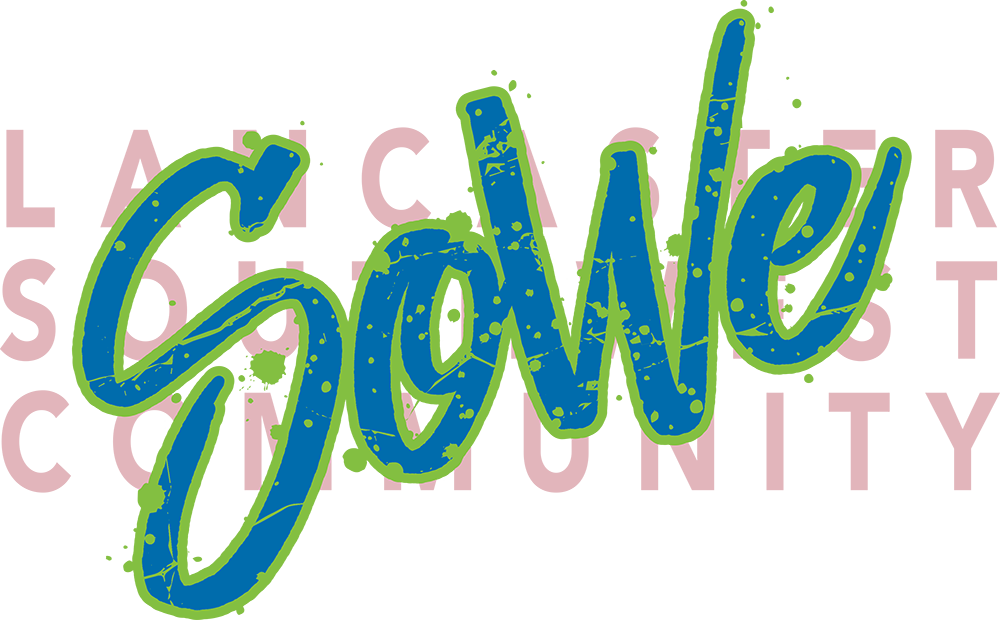Jim Gerhart, July 2020
In the mid-19th to early 20th centuries, Cabbage Hill boasted numerous hotels. Most didn’t look like the typical hotels of today, but instead looked like larger houses, with saloons on the first floor and rooms for rent in a rear wing. The proprietor and his family usually lived on the second floor above the saloon. Often hotels had a main front door for the saloon and hotel, and a second door off to one side for the proprietor’s upstairs living quarters. Most old hotels were on corners at intersections.
By far the earliest (1745) hotel near Cabbage Hill was the Golden Plough (later the Plow Tavern) at West King and Charlotte, just north of the Hill proper (razed in 1928). Probably the earliest hotel actually on the Hill was the Lafayette Hotel operated by George Hinkle in the 400 block of Manor Street in the mid-1840s (no longer there). After the Lafayette went out of business in the early 1850s, there were no more hotels on the Hill until after the Civil War, although there were always a couple saloons.
Between the Civil War and the beginning of the 20th century, eight iconic hotels were established in the historic core of the Hill, bounded by Manor, West Strawberry, Fremont, and Fairview. Each of these eight hotels flourished at least until the back-to-back challenges of Prohibition and the Great Depression, which put several of them out of the hotel business. The saloon part of their business, however, persisted through Prohibition, with many of them becoming speak-easies and occasionally running afoul of the Volstead Act. After World War II, many of the saloons in the old hotels were transformed into cafes, taverns, and bars through the late 1900s. Although none of the eight iconic hotels is a hotel anymore, all eight hotel buildings survive, and some still house successful businesses.
In their heyday, the eight hotels were the hubs of many Hill activities. Political meetings, speeches, and rallies often took place in the hotels, sometimes drawing hundreds of people. Many of the hotels served as polling places as well. Special events and celebrations often took place at the hotels, and music and dancing were common on weekends. Athletic, shooting, and other competitions between different hotel were frequently arranged. And, of course, Hill residents spent many a night gathered around the long bars drinking locally brewed beers. Occasionally, fights would break out and the police would be called.
The eight iconic Hill hotels are briefly described next, starting with the oldest:
Centennial Hotel, 128 West Strawberry—Established by Samuel Erisman in 1865, and named in 1876 during the Nation’s 100th birthday, the Centennial started out as a saloon in a one-story frame building. In 1892, the old building was replaced with a 3-story brick one (the current building) with 15 rooms, one bath, and a large bar room. Edward Kirchner ran the hotel and saloon during the challenging Prohibition years. Obie Miller’s Steak House operated in the building from the mid-1940s to the mid-1980s, and then Strawberry Hill Restaurant from the mid-1980s to 2012. The scars of two large saloon windows remain near the angled front door.
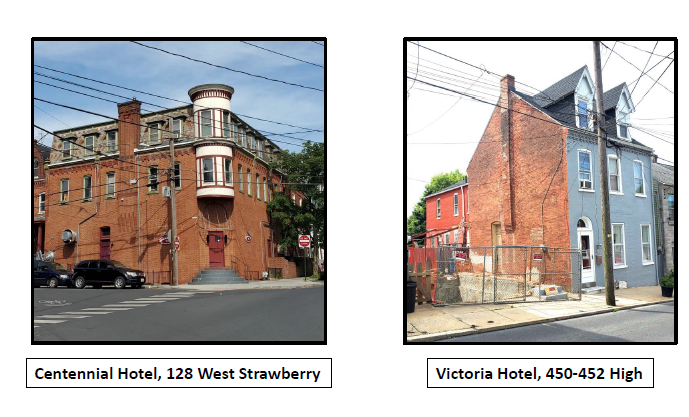
Victoria Hotel, 450-452 High—In 1865, Christian Diehl built a 2-story frame building and opened a saloon in it. When he died in 1877, his wife Victoria took over running the saloon, added a hotel component, and named it Victoria Hotel. She replaced the frame building with the current brick one about 1890. Joseph Fritsch ran the hotel and saloon until Prohibition in 1920. The hotel business closed in 1937, and Ziegler’s Café operated here in the 1940s. The outline of the old hotel entrance is still visible in the brick pattern on the façade.
La Pierre House, 476 Poplar—Martin Kempf built the current building and opened it as a saloon in 1873. After Kempf’s death, John Snyder took over in the 1880s and 1890s and added the hotel business, calling it La Pierre House. Lancaster brewer Charles Wacker bought the hotel and saloon in 1900 and Charles A. Kirchner ran it for him until 1930. At that time, the hotel business closed, and Albert Karch ran Fibber’s Café in the old saloon until 1953. Since then, it has been Danz Café, Brau House, Farrell’s Café, and My Linda’s Tavern, which closed in 1992.
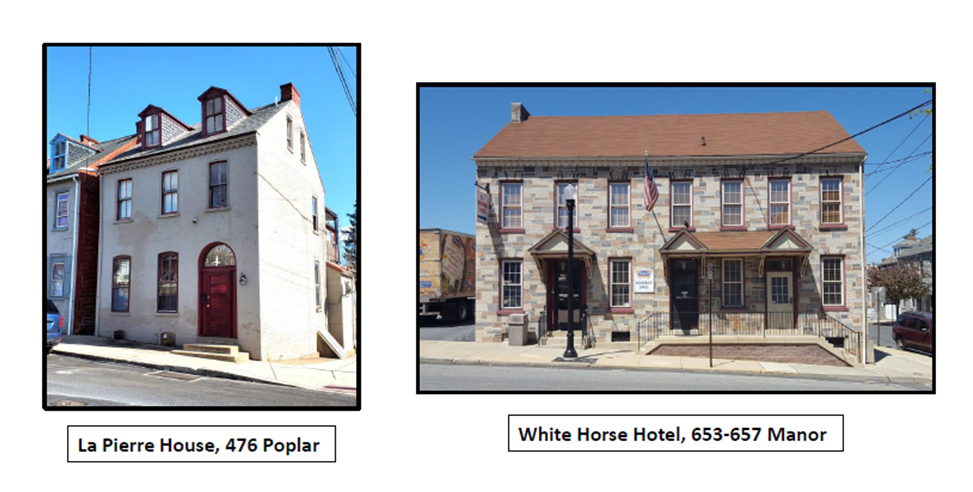
White Horse Hotel, 653-657 Manor—Albert Kohlhaas opened a saloon at this location in 1874, and built the current building as the White Horse Hotel about 1880. He sold the hotel to Frank Rieker of Rieker’s Brewery in 1899. John Kirchner ran the hotel for Rieker for about 20 years, followed by Thomas Goodhart for 15 more. Since the 1940s, the hotel has been closed, but numerous drinking and eating establishments have used the building—Noden’s Café, Bishop’s Café, Bartnichak’s Café, and most recently, O’Henry’s, which closed in the 1980s. Kunzler’s now uses the old hotel as its corporate offices. Multi-colored formstone now covers the original brick exterior.
Stumpf’s Hotel, 464-466 Manor—Started as Charles Vogt’s saloon in 1874, the original building became William Schneider’s Manor Street Hotel in the 1880s and 1890s. John Stumpf built a new hotel (the current building) on the site in 1902, with 16 rooms, hot and cold running water, and a huge cherry bar. Stumpf ran his hotel until 1937. After Stumpf’s Hotel closed, a series of owners operated cafes, taverns, and bars there, including Pat & Denze Café, Manor Bar, Gold Brick Tavern, Manor Tavern, and Cosmos Bar & Grill, which closed in 2011.
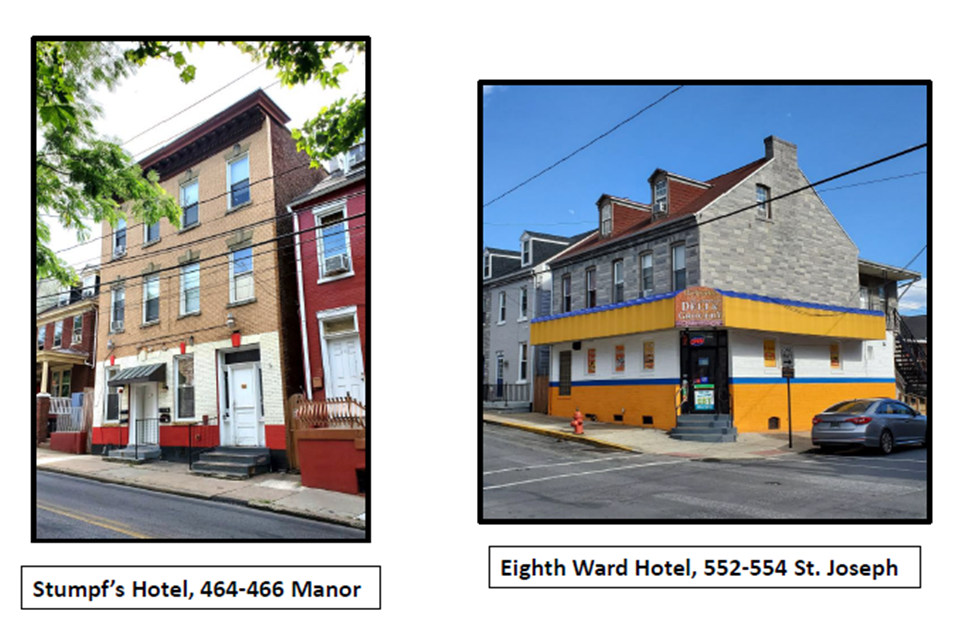
Eighth Ward Hotel, 552-554 St. Joseph—Alexander Gerz built the current building about 1874 as the new Green Cottage Hotel. Gerz’ heirs sold the hotel to Lucas Fritz, who ran it as the Eighth Ward Hotel until the late 1880s, when it was taken over by Fritz’ son Charles until about 1900. William Hoenninger, Jr., ran the hotel and saloon until about 1915. During Prohibition, Albert Hall sold soft drinks (at least) out of the dormant saloon. The hotel part of the business closed during the Great Depression. John Lermer and his wife Fannie ran Lermer’s Café from about 1940 to 1970, and from the late 1970s to 2012, it was the Starting Gate Inn. Formstone now disguises any covered-up doors and windows from the old building.
Fair View Hotel, 764-766 High—In 1894, Frank Schwarz bought a relatively new store and house on the corner of High and Fairview and a few years later he opened the Hotel Schwarz. Next, Casper Kirchner ran the hotel until 1910, naming it the Fair View Hotel. Matthew Miller, Carl Koenig, and Albert Bishop were the main proprietors of the Fair View for the next 30 years. From 1947 to 1990, William Steinbaecher took over, naming it Steinbaecher’s Hotel and expanding it farther along High. From the early 1990s to today, it has been O’Halloran’s Irish Pub. Formstone covers up any remnants of doors and windows from the old hotel and saloon.
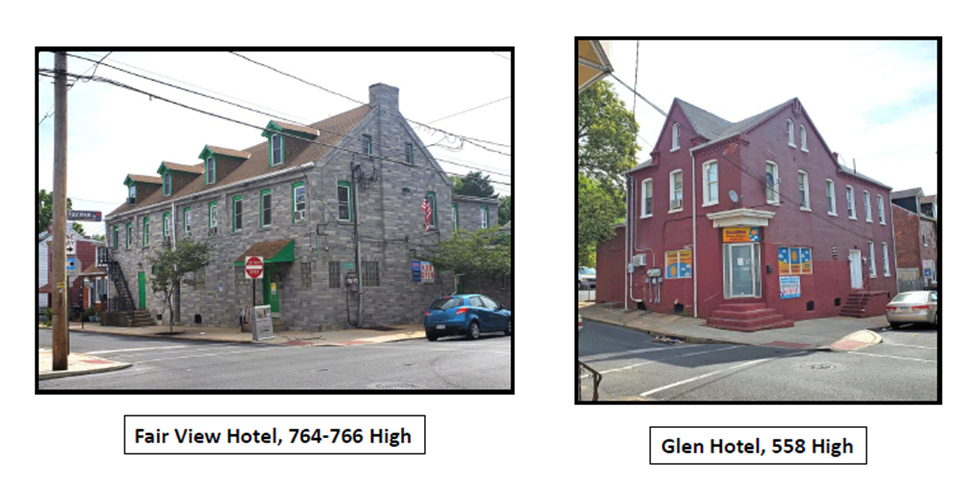
Glen Hotel, 558 High—The current building was built in the early 1890s as a grocery store for John Kaetz. By 1903, it was the Glen Hotel licensed to George Kirchner, and one owner later, William Kirchner was the proprietor until 1909. Several different men operated the Glen from 1909 into the 1930s, when the hotel closed and a series of cafes and taverns and other businesses took over, including Hammel’s Café, Koenig’s Café, Armand’s Tavern, the Glen Tavern, Tan Hoa Grocery, Peniel Church, and currently Sunshine Nursery Daycare Center.
The golden age of Cabbage Hill hotels is long past, but the buildings remain to remind us of how important they were to the social lives of Hill residents. Now the rooms in the old hotel buildings are apartments, as are many of the proprietor’s quarters on the second floor. But many of the old first-floor saloons have been converted for businesses, which is key to maintaining some of the neighborhood atmosphere of the old days on today’s Hill.
One last thing: Did anybody notice while you were reading this how many of the hotel proprietors were Kirchners? Edward, Charles, John, Casper, George, William—the Kirchners must have had the hospitality business in their genes!
